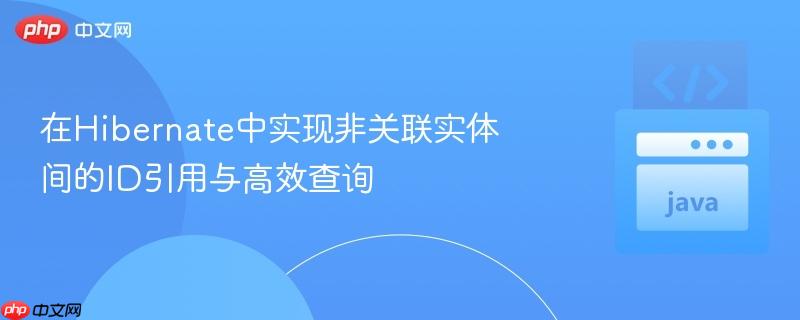
在复杂的业务系统中,我们常常需要追踪实体数据的历史变动。例如,一个“父实体”(ParentEntity)可以拥有多个“子实体”(ChildEntity),并且为了审计或历史记录的目的,我们可能为每个实体(包括父实体和子实体)都维护一个独立的“日志实体”(ParentLogEntity和ChildLogEntity)。这些日志实体通常包含与源实体相似的字段,并额外添加了记录的开始/结束时间戳,用于追踪数据随时间的变化。
一个常见的挑战是,如何在ChildLogEntity中引用其对应的ParentEntity的ID,而又不引入复杂的ORM映射关系。如果我们在ChildLogEntity中添加一个@ManyToOne到ParentEntity的映射,虽然可以实现引用,但可能会导致实体图变得过于复杂,特别是在查询时,可能需要通过Parent -> Child -> ChildLog这样的多级联接才能筛选出所需数据,这不仅增加了查询的复杂性,也可能带来不必要的性能开销,因为ORM层可能会尝试加载整个关联对象图。
更具体的问题在于,当ParentEntity及其关联的ChildEntity首次创建时,ParentEntity的ID是由Hibernate生成的。在ID尚未生成时,ChildLogEntity如何能有效地引用这个未来生成的ParentEntity ID,同时避免直接的@OneToMany关系,以简化模型并优化查询?
Hibernate Query Language (HQL) 和 JPA Query Language (JPQL) 提供了强大的查询能力,允许开发者在不依赖预定义ORM映射关系的情况下,通过JOIN...ON语法实现实体间的灵活关联。这意味着我们可以利用HQL/JPQL在查询层面,显式地将两个实体基于它们共享的某个字段进行连接,即使这些字段在实体定义中并未通过@OneToOne、@ManyToOne等注解建立直接的导航属性。
这种方法的核心在于,HQL/JPQL的JOIN...ON子句允许我们指定任意的连接条件,而不仅仅是基于ORM元数据生成的隐式连接。通过这种方式,我们可以在ChildLogEntity中存储一个普通的Long类型字段来保存ParentEntity的ID,然后在需要查询时,通过HQL/JPQL动态地将这两个实体连接起来。
假设我们有以下两个实体:
import javax.persistence.*;
import java.time.LocalDateTime;
// ParentEntity.java
@Entity
@Table(name = "parent_entity")
public class ParentEntity {
@Id
@GeneratedValue(strategy = GenerationType.IDENTITY)
private Long id; // Hibernate生成的ID
private String name;
// 构造函数、Getter和Setter
public ParentEntity() {}
public ParentEntity(String name) { this.name = name; }
public Long getId() { return id; }
public void setId(Long id) { this.id = id; }
public String getName() { return name; }
public void setName(String name) { this.name = name; }
@Override
public String toString() {
return "ParentEntity{id=" + id + ", name='" + name + "'}";
}
}
// ChildLogEntity.java
@Entity
@Table(name = "child_log_entity")
public class ChildLogEntity {
@Id
@GeneratedValue(strategy = GenerationType.IDENTITY)
private Long id;
// 这是一个普通字段,用于引用ParentEntity的ID,没有ORM映射注解
private Long parentId;
private String description;
private LocalDateTime logTimestamp;
// 构造函数、Getter和Setter
public ChildLogEntity() {}
public ChildLogEntity(Long parentId, String description) {
this.parentId = parentId;
this.description = description;
this.logTimestamp = LocalDateTime.now();
}
public Long getId() { return id; }
public void setId(Long id) { this.id = id; }
public Long getParentId() { return parentId; }
public void setParentId(Long parentId) { this.parentId = parentId; }
public String getDescription() { return description; }
public void setDescription(String description) { this.description = description; }
public LocalDateTime getLogTimestamp() { return logTimestamp; }
public void setLogTimestamp(LocalDateTime logTimestamp) { this.logTimestamp = logTimestamp; }
@Override
public String toString() {
return "ChildLogEntity{id=" + id + ", parentId=" + parentId + ", description='" + description + "', logTimestamp=" + logTimestamp + "}";
}
}现在,我们可以使用HQL/JPQL来查询,将ParentEntity和ChildLogEntity基于p.id = cl.parentId进行连接:
import javax.persistence.EntityManager;
import javax.persistence.EntityManagerFactory;
import javax.persistence.Persistence;
import javax.persistence.TypedQuery;
import java.util.List;
public class QueryExample {
public static void main(String[] args) {
EntityManagerFactory emf = Persistence.createEntityManagerFactory("my-persistence-unit"); // 替换为你的持久化单元名
EntityManager em = emf.createEntityManager();
try {
em.getTransaction().begin();
// 1. 创建并保存 ParentEntity,获取生成的ID
ParentEntity parent1 = new ParentEntity("Parent A");
em.persist(parent1);
ParentEntity parent2 = new ParentEntity("Parent B");
em.persist(parent2);
// 确保ID已生成并刷新到数据库
em.flush();
// 2. 使用 ParentEntity 的 ID 创建并保存 ChildLogEntity
ChildLogEntity log1_p1 = new ChildLogEntity(parent1.getId(), "Log entry for Parent A - action 1");
ChildLogEntity log2_p1 = new ChildLogEntity(parent1.getId(), "Log entry for Parent A - action 2");
ChildLogEntity log1_p2 = new ChildLogEntity(parent2.getId(), "Log entry for Parent B - action 1");
em.persist(log1_p1);
em.persist(log2_p1);
em.persist(log1_p2);
em.getTransaction().commit();
// 3. 执行HQL查询,连接 ParentEntity 和 ChildLogEntity
System.out.println("\n--- 查询所有 ParentEntity 及其关联的 ChildLogEntity ---");
String hql = "SELECT p, cl " +
"FROM ParentEntity p " +
"JOIN ChildLogEntity cl ON p.id = cl.parentId " +
"WHERE cl.description LIKE :keyword " + // 示例筛选条件
"ORDER BY p.id, cl.logTimestamp";
TypedQuery<Object[]> query = em.createQuery(hql, Object[].class);
query.setParameter("keyword", "%Parent A%"); // 查找描述中包含 "Parent A" 的日志
List<Object[]> results = query.getResultList();
for (Object[] result : results) {
ParentEntity parent = (ParentEntity) result[0];
ChildLogEntity childLog = (ChildLogEntity) result[1];
System.out.println("Parent: " + parent.getName() + " -> Log: " + childLog.getDescription());
}
} catch (Exception e) {
if (em.getTransaction().isActive()) {
em.getTransaction().rollback();
}
e.printStackTrace();
} finally {
em.close();
emf.close();
}
}
}上述HQL查询SELECT p, cl FROM ParentEntity p JOIN ChildLogEntity cl ON p.id = cl.parentId的工作原理如下:
通过这种方式,我们成功地在ChildLogEntity中引用了ParentEntity的ID,并且在查询时能够高效地将它们关联起来,而无需在ORM层面建立复杂的实体关系。
这种非关联实体间ID引用的方法在以下场景中尤为适用:
尽管这种方法提供了极大的灵活性,但在使用时仍需注意以下几点:
通过HQL/JPQL的JOIN...ON语法,我们可以在Hibernate应用中灵活地实现非关联实体间的ID引用和高效查询。这种方法在需要追踪历史数据、构建审计日志或优化特定查询场景时尤为有用,它允许我们解耦实体模型,避免不必要的实体图加载,从而提升应用程序的性能和可维护性。然而,开发者需要注意手动管理数据一致性,并通过数据库外键和索引来确保系统的健壮性和查询效率。
以上就是在Hibernate中实现非关联实体间的ID引用与高效查询的详细内容,更多请关注php中文网其它相关文章!

每个人都需要一台速度更快、更稳定的 PC。随着时间的推移,垃圾文件、旧注册表数据和不必要的后台进程会占用资源并降低性能。幸运的是,许多工具可以让 Windows 保持平稳运行。

Copyright 2014-2025 https://www.php.cn/ All Rights Reserved | php.cn | 湘ICP备2023035733号